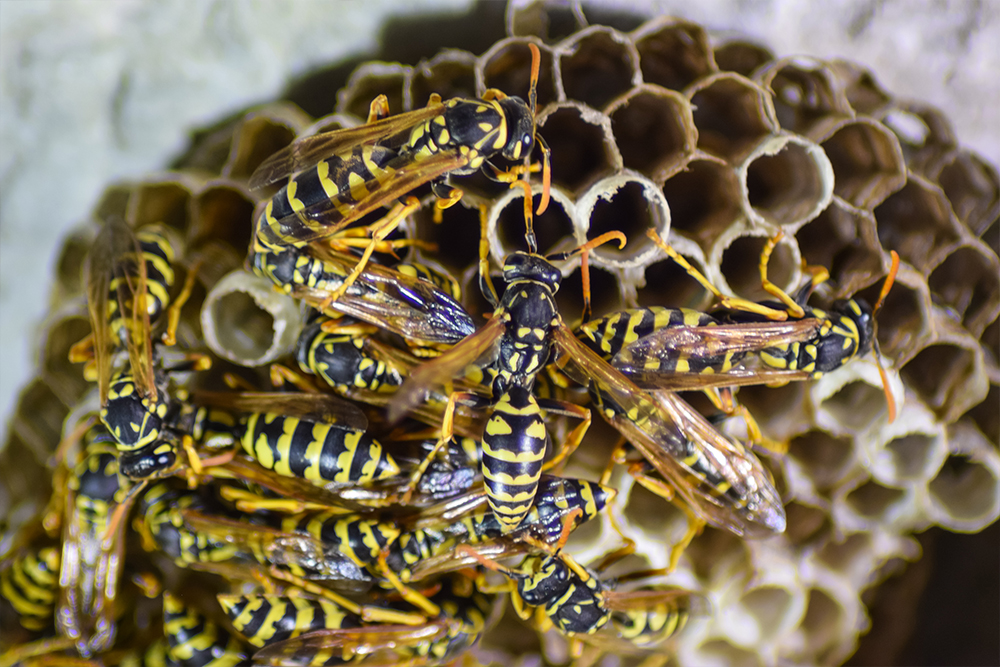There is something amusing about watching a full-grown adult run from a tiny, winged insect. The humor lies in the size discrepancy and the irony of something so small posing a threat to a creature who is so much bigger! If you’ve ever been stung by a wasp however, you would agree that it doesn’t matter how tiny the insect is; a wasp’s sting can pack quite a punch. Here are some interesting facts about these intimidating pests.
Differences Between A Wasp And A Bee
Bees and wasps are often mistaken, one for the other. Although they are closely related and both fly and sting, they have notable differences:
- Wasps have shiny, smooth skin. Bees are hairy.
- Bees swarm. Wasps do not.
- Bees are vegetarian pollinators. Wasps are predatory and both hunt and kill prey such as caterpillars and flies.
- Unlike a bee who only has one sting in their arsenal, a wasp can keep stinging you. This alone makes them much more menacing.
- Bees will attack when provoked. Wasps are aggressive predators. They naturally go looking for trouble.
Life In A Wasp Community
There are three types of wasps in a wasp community: queens, workers, and drones. Each type of wasp serves a particular function.
Queen Wasps
Queens run the show in their self-contained communities. They rule over the workers and the drones. Young fertilized queens are the only wasps to survive the winter. During the spring they build new nests, lay a multitude of eggs, then care for their offspring until they are old enough to become workers and protectors.
Worker Wasps
Worker wasps are infertile females. They spend their entire lives “serving” their queen as she gives birth to offspring. In addition to gathering food, attending the nest, and helping to raise young wasps, they also defend their colonies. Occasionally, a worker wasp will “rebel” and kill her queen.
Drones
Drones are male wasps. They are unable to sting. Drones aren’t as productive as the workers. They do a little to help keep the colony clean and sometimes feed the babies. But their main function is to mate with the queen. Unfortunately for them, they die shortly after.
How To Treat A Wasp Sting
Before you decide to swat and kill one of these insects, be aware that once they have been squashed, the wasp will release a pheromone. This pheromone alerts nearby wasps which then become more aggressive. Not only did you vex the one wasp that was an easy kill, you just told his buddies that there is a fight to be had.
The irritation from a wasp’s sting should only last about 24 hours. To relieve the pain, wash the area clean with soap and water, then apply a cold compress. Rubbing a little deodorant containing aluminum onto the sting can also help minimize irritation.
A small number of people can go into anaphylactic shock from a wasp sting and suffer serious illness. If you experience any of the following, seek immediate medical attention:
- Severe swelling of the face, lips, throat;
- Itching or hives;
- Wheezing or gasping for air;
- Nausea or vomiting;
- Dizziness;
- Stomach cramps;
- Blood pressure drop;
- Weak or racing pulse.
McCarthy Pest & Termite Control
If you’ve noticed wasps or a wasp nest around your home, don’t wait to get stung! Call us today. Our technicians are trained to treat for these potentially harmful insects and know how to safely remove their nests. Don’t be THAT person caught on video flailing while running from a tiny little wasp after you’ve tried to swat it or knock down its nest. Instead trust the professionals at McCarthy Pest and Termite Control to get rid of these pests for you.






